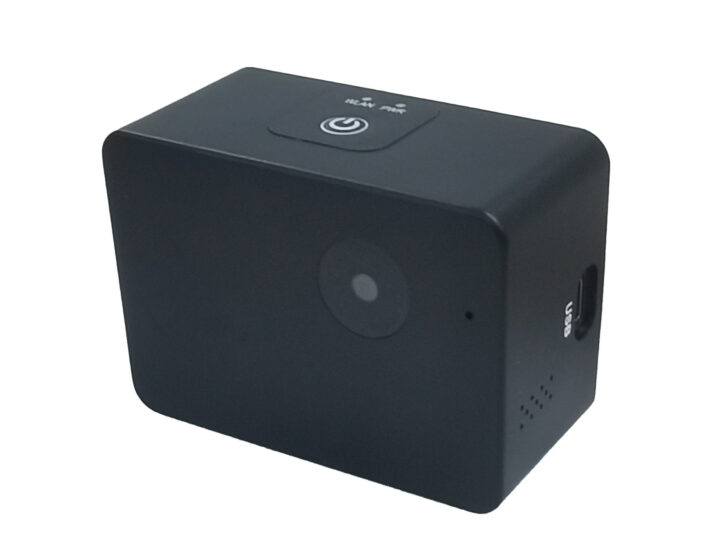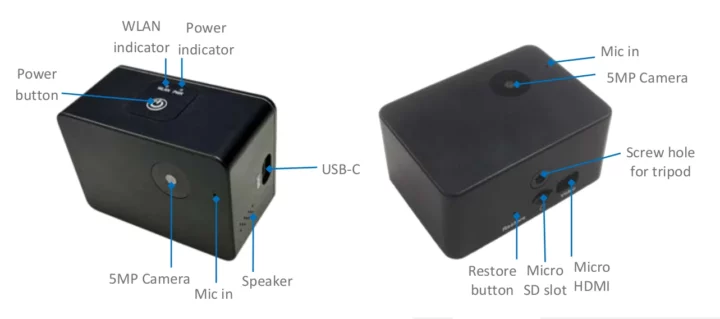Vantron HCAM26 is an IP camera based on the company’s VT-MOB-AH-L sub-GHz 802.11ah WiFi HaLow module itself equipped with Morse Micro MM6108 RISC-V SoC and offering up to 1km range and better wall penetration than WiFi security cameras operating at 2.4 GHz or 5GHz frequencies.
The Linux camera comes with 1GB RAM and 8GB eMMC flash, features a 5MP (2592 x 1944) camera sensor, supports AI features through a 2.0 TOPS NPU integrated into the main SoC, and is also fitted with a speaker and microphone for two-way audio, and a micro HDMI port to monitor the camera output. A 2,600mAh Li-ion battery powers the camera.
Vantron HCAM26 specifications:
- SoC – Unname, but most likely Rockchip RV1126
- CPU – Quad-core Arm Cortex-A7 32-bit vision processor with RISC-V core
- ISP – 14MP ISP
- VPU
- H.265/H.264 codecs
- Frame rate – 3840 x 2160 @30 fps + 1080p @30 fps encoding supported ; 3840 x 2160 @30 fps encoding + 3840 x 2160 @30 fps decoding supported
- AI accelerator – 2.0 TOPS NPU (INT8/INT16 support)
- System Memory – 1GB DDR4
- Storage
- 8GB eMMC flash
- MicroSD card slot
- Camera
- Image sensor – 5 MP 1/4” CMOS image sensor
- Resolution – 2592 x 1944 (QSXGA)
- Output format – 8-/10-bit RGB RAW output
- Frame rate – VGA: 30fps ; QVGA, QQVGA, CIF: 60fps ; QCIF, QQCIF: 120fps
- Pixel size – 1.4μm x 1.4μm
- Focal length – EFL: 1.785mm ; BFL: 0.934mm
- FOV – 73.9° (V), 92.4° (H), 119.9° (D)
- Object distance – 20cm~180cm (I suppose for motion/object detection?)
- Aperture – F2.4
- Lens construction – 6P
- Wireless
- IEEE 802. 11ah standard (WiFi HaLow)
- Frequency range – US: 902MHz ~ 928MHz ; JP: 916.5MHz ~ 927.5MHz
- Wi-Fi mode – Station
- Security – WPA3
- Video Output – Micro HDMI up to 4Kp30 without audio
- Audio – Built-in microphone and 1W speaker for two-way audio
- USB – 1x USB Type-C port for power and flashing images
- Misc
- Tripod connection
- Watchdog timer
- Power LED, Wi-Fi HaLow connectivity LED
- Power button, Restore button (reboot/factory reset)
- Battery – 2,600 mAh, good for up to 4 hours of continuous operation (TBC as it seems short…).
- Power Supply – 5V/2A DC via the USB Type-C
- Power Consumption – About 3 Watts (average) when active
- Dimensions – 91.6 x 65 x 47.2mm
- Temperature Range – Operating: -10°C ~ +50°C ; Storage: -20°C ~ +70°C
- Certifications – FCC, TELEC
Vantron Technology provides a Yocto-based Linux SDK for the camera and a mobile app for remote view, but no other publicly available details are available about software support. Since the 900MHz frequency range needed for WiFi Halow is not commonly used in routers, you’ll also need a HaLow access point to connect the IP camera to such as the company’s HAP101 or HAP103 or third-party models like the AsiaRF AP7688-WHM. Another solution is to add a WiFi Halow USB adapter, mini PCIe module, or Raspberry Pi HAT that supports host mode to any computer or SBC with the necessary connectors or sockets.
We first wrote about 802.11ah Wi-Fi operating at 900 MHz for low-power IoT connectivity in 2014, and the standard got its WiFi HaLow commercial name in 2016, but adoption has been extremely slow. Its relatively high bandwidth compared to other low-power WAN standards like LoRaWAN and Sigfox makes it especially useful for long-range battery-powered IP or security cameras, and less so for things like sensors. There are very few WiFI Halow cameras available as companies mostly sell HaLow gateway for Ethernet-based IP cameras. Having said that, I can see Tuya offers some HaLow CCTV camera systems on AliExpress, and Lorex sells a few pricy systems on Amazon, but none are especially popular.
As I understand, Vantron Technology does not sell directly to consumers but rather provides solutions to manufacturers which explains why a Yocto SDK is provided for the camera. Additional information may be found on the product page.
Thanks to David for the tip.

Jean-Luc started CNX Software in 2010 as a part-time endeavor, before quitting his job as a software engineering manager, and starting to write daily news, and reviews full time later in 2011.
Support CNX Software! Donate via cryptocurrencies, become a Patron on Patreon, or purchase goods on Amazon or Aliexpress






